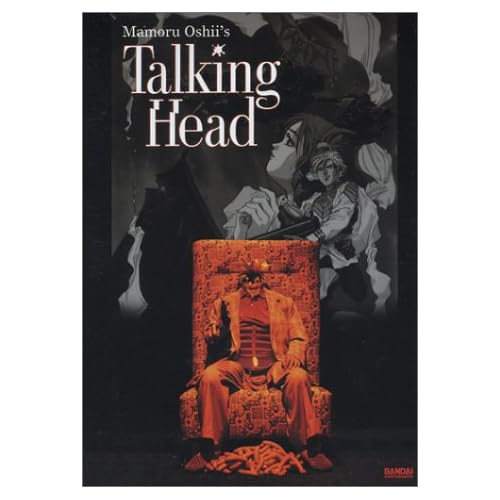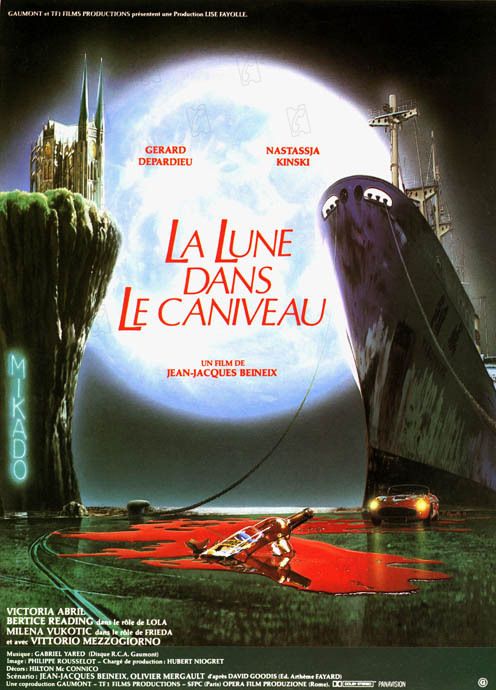Jean-Jacques Beineix is a curious director. Throughout these last two years, I've been delving deeper into art house features, but watching Beineix's films is a flashback to the commercial cinema that I grew up on. Not to imply that one market is better than the other, but the independent/art house world and the commercial industry have two different mindsets. With Beineix's first three features, it is obvious that he is trying to reach a wide audience, but there is a small, almost imperceptible tinge of personality placed into each of his films. Yes, he may just be an auteur. The most obvious aspect I've noticed in these first three features (Diva; The Moon in the Gutter; Betty Blue) is the persistent sense of longing. All three features have strong, believable romantic themes, and Beineix, like so many French artists, has a slight obsession with finding and defining love.
The Moon in the Gutter is based from the book of the same title by David Goodis. Like most Americans, I never even heard of Goodis until watching Truffaut's Shoot the Piano Player. Some may have also seen him parodied in Godard's Made in U.S.A.. In Beineix's adaption of Goodis' novel, Gerard (Gerard Depardieu) is a stevedore who falls into a romance with a wealthy woman, Loretta (Nastassja Kinski). In this French adaption, the setting is switched from Goodis' hometown of Philadelphia to the ports of Marseilles. Gerard's neighborhood is quite squalid, reminding one of the slums in Jean Renoir's Les Bas-fonds.
Aligned with these lowly settings and romantic sentiments is a plot; Gerard plays a man who can be perfectly described as the strong and silent type. His emotion has been stripped from him after the death of his sister, raped and forced to suicide. Every night, he visits the bloodstained crime scene and broods over his existence, wishing to have a chance to leave the ports. Almost anchoring him down to his muted life is his lover, Bella, brilliantly and passionately played by Victoria Abril. She accepts her social standing in the slums, but for him, committing to her would mean accepting a life that he does not care for.
Gerard's luck may begin to shift when he encounters another melancholic, yet well-dressed and seemingly out of place man at the town bar. He grieves over the past like Gerard, and is only consoled when his gorgeous sister, Loretta enters the room. Fans, like myself, of Nastassja Kinski's flawless performance in Paris, Texas, will not be letdown in this film. Not only is she undeniably gorgeous (quite a force to be reckoned with in curls, scarlet lipstick, and dark garments), but Beineix, like Wenders, doesn't dare interrupt her performance with a flurry of shot-reverse shot editing. Her introduction into the picture may have been a bit overdone, with a close-up that could have distinguished nasal hairs, and a fan turned up too high, but when she speaks, one is wholly absorbed. Like her peepshow reunion scene in Paris, Texas, I had thoroughly lost myself in the scene when she and Depardieu ride and reminisce through the docks.
Following the dock ride are dreams and/or alcoholic binges. Gerard continues his reluctant courtship with Loretta, as she is the more active side of the relationship, while fearing that she may reach the same fate as his sister. Bella continues to be a comfort, yet somewhat of a nuisance for him, creating a threatening problem for him, and through all that he may have just found the man who drove his sister to death.
A small amount of research will show that this film was thrashed by critics upon release. Roger Ebert even seemed to not have much interest in it. It understandably had a cult following after its release, and would probably be just as polarizing today if it had an official DVD release in the States. Beineix doesn't really resolve anything in this film, but he is one of the few directors who has enough stylistic merit to make a good film without a fully coherent plot. For some of the lunacy in his cinema, like the ice-biting and the banana warehouse fight in this film, Beineix comes off with a certain charm that I can't ignore. He fully believes in his colorized recreation of film-noir (this film owes a lot to the aesthetic choices of 40's American cinema), and I have a respect for his enthusiasm, even if it didn't come off with perfection. This fixation with the director's work may just be a passing interest, but I would like to follow-up this experience with a viewing of Roselyne and the Lions. It seems that Beineix has simply fallen out of favor these days; most of his films are only available in France, and he hasn't released a feature in 6 years.










